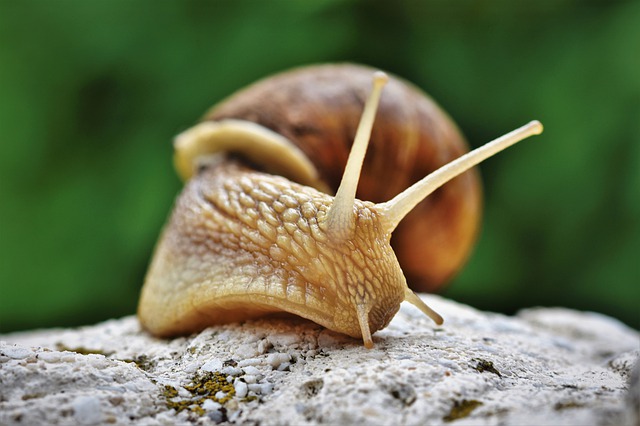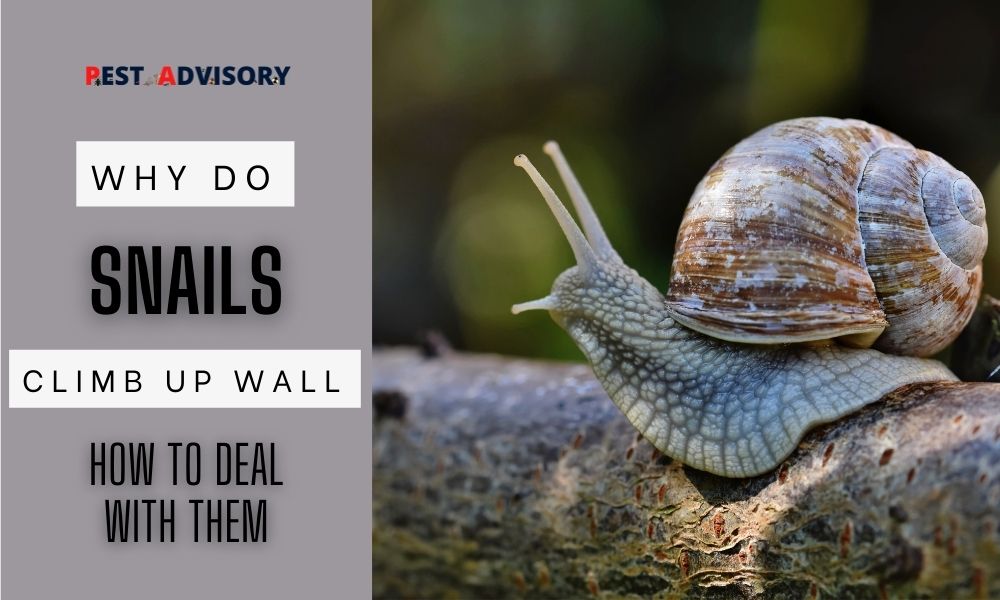If you’ve seen snails slowly crawling in the walls of your house, then you might be curious why they end up there.
At first, you might be annoyed and worried about a possible snail infestation, but it’s better to learn the reasons why snails are climbing up in your homes.
Surely, there might be reasons why snails are fond of climbing up on your walls and fences.
In this article, we will learn and dig deeper into the reasons why snails are climbing up in your homes.
You might be surprised by the instinct of these mollusks and how they fight for their survival higher up on the ground.
Read on to know more of these reasons why snails end up crawling into your homes.
Why Do Snails Climb Up Walls
If you’ve seen snails climbing up in your house, you might want to know the reasons behind this.
They can also be found climbing poles, fences, and even trees!
Let us check some of the reasons why snails are crawling up your house.
To Find Food
Snails are known to be herbivores and may climb walls in search of food sources such as algae, moss, or other vegetation that may be present on the walls or in the surrounding area.
Avoid Being Stomped On
Living on the ground is a dangerous bargain for snails of small sizes.
Other animals and even humans can potentially stomp or squash them instantly.
And, their slow movement even adds to the risk of them being trampled on. When a snail is squashed, its outer shell is destroyed.
Now, if you’ve seen a snail without its protective shell, then those are slugs; slugs evolve from snails and survive without outer shells covering their bodies.
Escape Unfavorable Conditions
Snails may climb walls to escape from unfavorable conditions such as extreme temperatures, high humidity, or excessive moisture on the ground, which could potentially harm or disrupt their normal activities.
Search for a Mate
Snails are hermaphrodites, meaning they have both male and female reproductive organs, but they still need to find a mate to reproduce.
Climbing walls could be a way for snails to increase their chances of finding a suitable mate by expanding their search area.
Moisture
Snails require a moist environment to thrive as they breathe through a specialized structure called a pallial cavity, which needs to be kept moist.
Climbing walls could be a strategy for snails to find a moister area, especially during dry or hot conditions.
To Lay Eggs
Some snail species lay their eggs in elevated locations, including walls, as a way to protect their eggs from predators or from being submerged in water.
Climbing walls could provide a safer and drier location for snails to lay their eggs.
Suitable Nesting Sites
Snails may climb walls to find suitable nesting sites, such as crevices or gaps in the walls, where they can lay their eggs and protect themselves from environmental hazards.
It’s important to note that snail behavior may vary depending on the species and environmental conditions, so the reasons for snails climbing walls may not be universal and could vary in different situations.

How to Get Rid of Snails On the House
Remove Food Sources
Remove Debris
Snails are attracted to decaying leaves, plant debris, and other organic matter. Clearing away any debris from the base of the wall can help reduce the snail population.
Trim Vegetation
Snails like to hide in tall grasses and overgrown vegetation. Trimming back any nearby plants or shrubs can help discourage snails from climbing up the walls.
Clean Gutters
Clogged gutters can provide a moist environment for snails. Cleaning out gutters regularly can prevent snails from breeding and congregating in these areas.
Use Mulch Alternatives
Mulch can provide a food source and a hiding place for snails. Consider using alternatives such as pebbles or gravel around the base of the wall instead.
Create Physical Barriers
Copper Barriers
Snails dislike copper and will avoid touching it. Copper strips or tape can be attached to the base of the wall, creating a barrier that snails cannot cross.
Mesh Barriers
Fine mesh screens or netting can be placed over windows, vents, or any other openings in the walls to keep snails out.
Barriers Made from Natural Materials
Barriers made from natural materials such as crushed eggshells, pine needles, or coffee grounds can be effective in repelling snails.
These materials create a rough and abrasive surface that snails do not like to climb on.
Apply Repellents
Diatomaceous Earth
Diatomaceous earth is a natural substance that can be used as a repellent for snails. It works by absorbing moisture from the snails’ bodies, which causes them to become dehydrated and die.
Garlic Spray
Garlic spray is another popular repellent for snails. The strong scent of garlic repels the snails and keeps them from climbing up the walls.
Salt Water
A simple solution of salt water can be used as a DIY repellent for snails. Simply mix salt with water and spray it on the walls.
The salt will dry out the snails and prevent them from climbing up.
Note: Salt can be harmful to plants and may damage surfaces, so use it sparingly and avoid contact with desirable plants or materials.
Handpick and Relocate
Go out at Night
Snails are most active at night, so it is best to go out and handpick them during that time. Take a flashlight and wear gloves to protect your hands.
Pick off Snails
Use your hands or a pair of tongs to pick off the snails from the wall. Be careful not to crush them as they can release an unpleasant odor.
Relocate Snails
Once you have collected the snails, relocate them to an area away from your home. Choose an area with vegetation where they can find food and moisture.
Repeat Regularly
Handpicking should be carried out regularly to prevent the snail population from growing back.
Keep Walls Clean
Power Wash the Walls
A power washer can be used to remove any debris, dirt, or grime on the walls.
This will help eliminate any potential food sources for snails and discourage them from climbing up.
Use Vinegar Solution
A solution of vinegar and water can be used to clean walls naturally.
Simply mix equal parts of vinegar and water in a spray bottle and apply it to the walls. Let the solution sit for a few minutes before wiping it off with a damp cloth.
Regular Sweeping
Regularly sweeping leaves, debris, and other matter from around the base of the walls can help reduce the presence of snails.
Keep the Area Dry
Snails thrive in moist environments, so keeping the area around the walls dry can help prevent them from climbing up.
Consider installing proper drainage systems around your home to ensure that water does not accumulate near the walls.
Seal Cracks and Gaps
Snails can hide in small cracks and crevices on the wall. Sealing these gaps and cracks with caulking or sealant can prevent snails from finding shelter there.
Paint the Walls
Applying a fresh coat of paint can create a smooth surface that snails find difficult to climb.
Monitor and Remove Hiding Spots
Inspect Regularly
Regularly inspect the area around the walls to identify any hiding spots where snails may be congregating. Look for areas with moist soil, rocks, and debris.
Remove Hiding Spots
Once you have identified potential hiding spots, remove them. Clear away any fallen leaves, compost piles, or other organic matter that can provide shelter for snails.
Repeat Regularly
Monitoring and removing hiding spots should be carried out regularly to prevent snail populations from growing back.

Frequently Asked Questions
Are Snails Bad To Have Around Your House?
Snails can be considered pests as they can damage plants in gardens and leave slime trails on surfaces.
However, they also serve as decomposers in ecosystems and can be beneficial in controlling other pests.
Keeping them in check with natural or humane methods is recommended if you do not want them around your house.
Why are Snails Crawling Up My House?
Snails may crawl up your house seeking shelter, moisture, or food.
What attracts snails to your house can be the cool and damp environment typically found on walls, especially during dry or hot weather. Snails are slow-moving creatures that leave behind a slimy trail, which helps them move across surfaces like walls.
Regularly cleaning and sealing potential entry points can deter snails from crawling up your house.
What Should I Do if There’s a Florida Snails On My House?
If you find Florida Snails in your house, it’s best to gently remove them and relocate them to a suitable natural habitat.
Avoid using harmful chemicals or methods that could harm the snails or the environment.
It’s important to respect wildlife and follow local laws and regulations regarding snail removal or relocation.
Final Thoughts
Seeing snails climbing up in your houses is not just a spur-of-the-moment animal instinct.
As it turns out, there are various reasons why snails or different other pests like grasshoppers, tiny bugs, etc., are wriggling in your homes.
This time, you have learned why snails are climbing up in the walls or fences of your house.
And in no time, you might be able to employ ways to get rid of these slimy mollusks in your home.
Thanks for reading!
